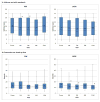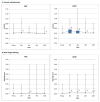Chronic dry eye in photorefractive keratectomy and laser in situ keratomileusis: Manifestations, incidence, and predictive factors
- PMID: 26796443
- PMCID: PMC5702539
- DOI: 10.1016/j.jcrs.2015.06.037
Chronic dry eye in photorefractive keratectomy and laser in situ keratomileusis: Manifestations, incidence, and predictive factors
Abstract
Purpose: To evaluate dry-eye manifestations after photorefractive keratectomy (PRK) and laser in situ keratomileusis (LASIK) and determine the incidence and predictive factors of chronic dry eye using a set of dry-eye criteria.
Setting: Walter Reed Army Medical Center, Washington, DC, USA.
Design: Prospective, non-randomized clinical study.
Methods: Dry-eye evaluation was performed before and after surgery. Main outcome measures included dry-eye manifestations, incidence, and predictive factors of chronic dry eye.
Results: This study comprised 143 active-duty U.S. Army personnel, ages 29.9 ± 5.2 years, with myopia or myopic astigmatism (manifest spherical equivalent -3.83 ± 1.96 diopters) having PRK or LASIK. Schirmer scores, corneal sensitivity, ocular surface staining, surface regularity index, and responses to dry-eye questionnaire significantly changed over time after PRK. After LASIK, significant changes were observed in tear breakup time, corneal sensitivity, ocular surface staining, and responses to questionnaire. Twelve months postoperatively, 5.0% of PRK and 0.8% of LASIK participants developed chronic dry eye. Regression analysis showed that pre-operatively lower Schirmer score will significantly influence development of chronic dry eye after PRK, whereas preoperatively, lower Schirmer score or higher ocular surface staining score will significantly influence the occurrence of chronic dry eye after LASIK.
Conclusions: Chronic dry eye was uncommon after PRK and LASIK. Ocular surface and tear-film characteristics during pre-operative examination might help to predict chronic dry-eye development in PRK and LASIK.
Financial disclosure: The authors have no financial interest in any product, drug, instrument, or equipment discussed in this manuscript.
Copyright © 2015 ASCRS and ESCRS. All rights reserved.
Conflict of interest statement
Figures





References
-
- Ang RT, Dartt DA, Tsubota K. Dry eye after refractive surgery. Curr Opin Ophthalmol. 2001;12(4):318–22. - PubMed
-
- The epidemiology of dry eye disease: report of the Epidemiology Subcommittee of the International Dry Eye WorkShop (2007) Ocul Surf. 2007 Apr;5(2):93–107. - PubMed
-
- Nichols KK, Nichols JJ, Mitchell GL. The reliability and validity of McMonnies Dry Eye Index. Cornea. 2004 May;23(4):365–71. - PubMed
-
- De Paiva CS, Chen Z, Koch DD, Hamill MB, Manuel FK, Hassan SS, Wilhelmus KR, Pflugfelder SC. The incidence and risk factors for developing dry eye after myopic LASIK. Am J Ophthalmol. 2006 Mar;141(3):438–45. - PubMed
-
- De Paiva CS, Lindsey JL, Pflugfelder SC. Assessing the severity of keratitis sicca with videokeratoscopic indices. Ophthalmology. 2003;110(6):1102–9. - PubMed
Publication types
MeSH terms
Grants and funding
LinkOut - more resources
Full Text Sources
Other Literature Sources
Medical

